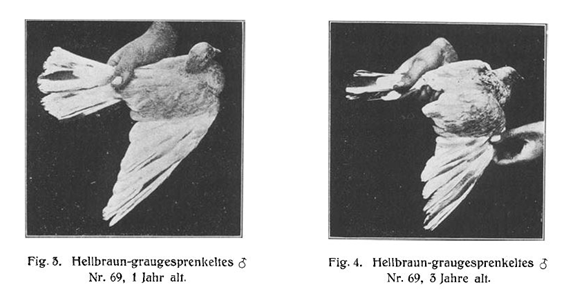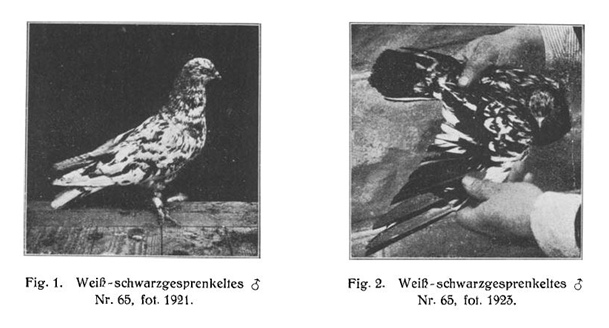|
Sprinkle (Stipple) at the Domestic Pigeon
The
first who analyzed the genetics of the 'gesprenkelte' domestic
pigeon were the Norwegian scientists Christie and Wriedt. The today
Brown- and Yellow Stipper of the Danish Tumblers were called 'Brown-Blacksprinkled'
and 'Light Brown Greysprinkled'. In Danish they are named today 'brune
Staenkede' and 'gule Staenkede'.

(Light Brown Greysprinkled at the age of 1 and 3 years respectively)
Quelle: Christie und Wriedt 1925
Danish Grey Stipper (gra Staenked) for the authors who published
1925 in German language white blacksprinkled. They also mentioned
the darkening with age and demonstrated that in the photo of a
'white blacksprinkle' at different age.

(White blacksprinkle after the first molt and two years later)
Quelle: Christie und Wriedt 1925
The authors also saw the great variability of the colorations and
the existence of many intermediate types. Those between brown,
yellow and white blacksprinkled in Germany are standardized as
'multi-colored' (Vielfarbige). The black stipple or sprinkle effect
genetically is caused by the stipple trait St that was introduced by
outcrosses upon English Short Faced Almond tumblers before 1900.
We may first separate those sprinkled pigeons that have a
brown/yellow or almond-colored ground, those are
-
Almonds
of the English Short Faced Tümmler with almondnut brown/yellow
ground and
-
Multicolored
with less requirements at the ground, some yellow, however is
necessary to qualify for this group, otherwise it is a sprinkle.
In the USA both groups are called Almonds, the first might be called
'classical almonds', the second group almonds or light almonds, not
to say 'Almond Light'.
 
English Short Faced
Tumbler cocks almond
 
German Modena multi-colored with the accepted variation in the
coloration at a German exhibition
For Multi-colored and Almonds black sprinkles are required in the
standards, for sprinkles that attribute is part of the colorations'
name:
-
White with black sprinkles are called Blacksprinkle and as
dilutes Dunsprinkles
-
White with blue sprinkles are called Bluesprinkle,
-
White with red and yellow sprinkles are Red- and Yellowsprinkle,
better would be to say dominant red and dominant yellow sprinkles,
since they have a dominant red base color. Recessive red with the
St-gene become DeRoy instead of stipple. Many supposed red sprinkle
shown in the past did not even had the St-gene but another gene
combination.
Finally we distinguish also at the shows
-
Silverwhite with black sprinkles as Silversprinkle.
At Oriental Rollers the term Sprenkel or Sprinkle is common, at
Danish Tumblers the term Stipper or Stipple, Danish 'Staenkede' from
which the symbol St was derived.
Beginners often speak from black almonds instead of white
blacksprinkle or stipper. How could a white/black pigeons show the
almond color, and if it does not, why should it be called so?
 
Oriental Roller and Pomeranian Eye Crested Highflier blacksprinkle
 
Canario-Pouter bluesprinkle and bluesprinkle cock from the author's
loft
 
Red (dominant red) sprinkle from the author's loft and Oriental
Roller silversprinkle at the VDT-Show in Erfurt 2016
 
Silversprinkle at a Lipsia-Show and silversprinkle Giant Homer shown
as blacksprinkle at the VDT-Show in Erfurt 2016 as a new coloration
Black-, Dun-, Red- and Yellowsprinkles got their name from the
coloration of their sprinkles at a white ground. Silversprinkle,
however, got their designation from the white-silver ground, the
sprinkles in reality or also blue/black.
Danish Grey Stipples are not quite identical with Blacksprinkles of
other breeds like Oriental Roller. At breast and neck they shall
have a silky reddish glance. Finally we should mention that some
faded Texan cocks may appear identical to some blue and black
sprinkles. Also the difference or common elements of silver
sprinkles to some Spread Qualmond is not yet settled.
At the VDT-Show in Erfurt nice Giant Homers were shown as a new
creation to get standardized. They were still discussed in the show
report at this homepage. One of the pigeons is shown above again.
Unfortunately they were announced as blacksprenkle and also accepted
from the judges as such. The photo of one of them in the German
Geflügel-Zeitung with the wrong designation as blacksprinkle is an
irritating signal to the fancy. The difference between silver- and
blacksprenkle seems to be not as easy as it is believed.
A discussion of the genetics of the different sprinkles may be found
in the author's books 'Pigeon Genetics' in English language and 'Genetik
der Taubenfärbungen' in German language. Photos of the different
variations are shown in 'Taubenfärbungen. Coulerations in the
Domestic Pigeon'.
 ![Titelblatt-Endversion[1].JPG](sprinkle_at_the_domestic_Pigeon-Dateien/image027.jpg) 
|